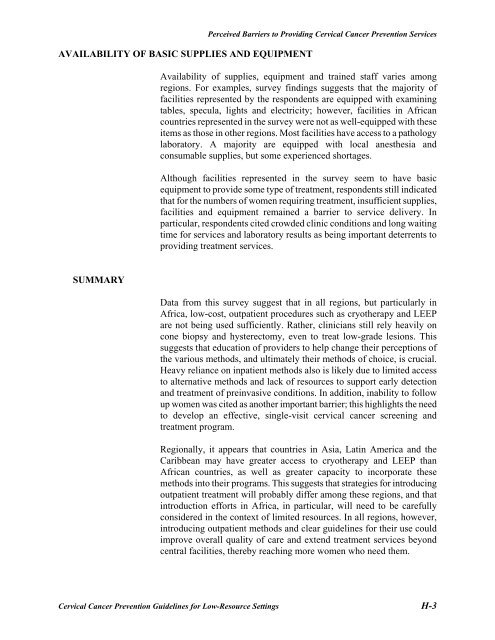Reference Manual - IARC Screening Group
Reference Manual - IARC Screening Group
Reference Manual - IARC Screening Group
Create successful ePaper yourself
Turn your PDF publications into a flip-book with our unique Google optimized e-Paper software.
AVAILABILITY OF BASIC SUPPLIES AND EQUIPMENTPerceived Barriers to Providing Cervical Cancer Prevention ServicesAvailability of supplies, equipment and trained staff varies amongregions. For examples, survey findings suggests that the majority offacilities represented by the respondents are equipped with examiningtables, specula, lights and electricity; however, facilities in Africancountries represented in the survey were not as well-equipped with theseitems as those in other regions. Most facilities have access to a pathologylaboratory. A majority are equipped with local anesthesia andconsumable supplies, but some experienced shortages.Although facilities represented in the survey seem to have basicequipment to provide some type of treatment, respondents still indicatedthat for the numbers of women requiring treatment, insufficient supplies,facilities and equipment remained a barrier to service delivery. Inparticular, respondents cited crowded clinic conditions and long waitingtime for services and laboratory results as being important deterrents toproviding treatment services.SUMMARYData from this survey suggest that in all regions, but particularly inAfrica, low-cost, outpatient procedures such as cryotherapy and LEEPare not being used sufficiently. Rather, clinicians still rely heavily oncone biopsy and hysterectomy, even to treat low-grade lesions. Thissuggests that education of providers to help change their perceptions ofthe various methods, and ultimately their methods of choice, is crucial.Heavy reliance on inpatient methods also is likely due to limited accessto alternative methods and lack of resources to support early detectionand treatment of preinvasive conditions. In addition, inability to followup women was cited as another important barrier; this highlights the needto develop an effective, single-visit cervical cancer screening andtreatment program.Regionally, it appears that countries in Asia, Latin America and theCaribbean may have greater access to cryotherapy and LEEP thanAfrican countries, as well as greater capacity to incorporate thesemethods into their programs. This suggests that strategies for introducingoutpatient treatment will probably differ among these regions, and thatintroduction efforts in Africa, in particular, will need to be carefullyconsidered in the context of limited resources. In all regions, however,introducing outpatient methods and clear guidelines for their use couldimprove overall quality of care and extend treatment services beyondcentral facilities, thereby reaching more women who need them.Cervical Cancer Prevention Guidelines for Low-Resource Settings H-3
















